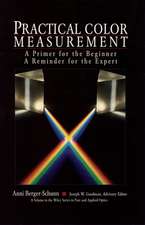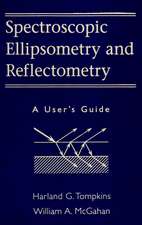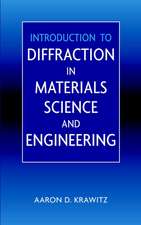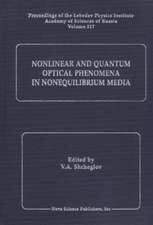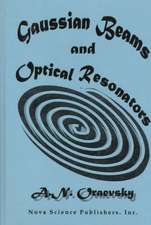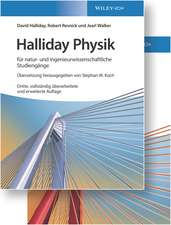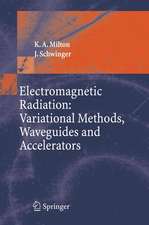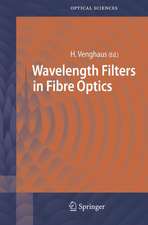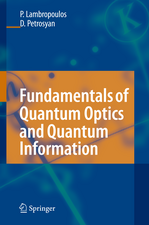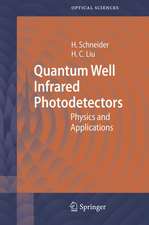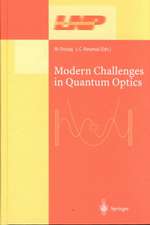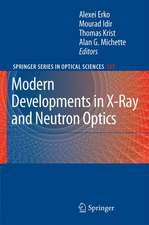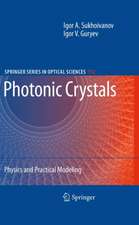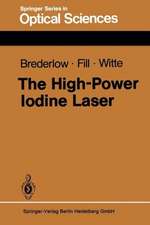Semiconductor-Laser Physics
Autor Weng W. Chow, Stephan W. Koch, Murray III Sargenten Limba Engleză Paperback – 18 sep 2011
Preț: 400.85 lei
Nou
Puncte Express: 601
Preț estimativ în valută:
76.71€ • 82.02$ • 63.95£
76.71€ • 82.02$ • 63.95£
Carte tipărită la comandă
Livrare economică 18 aprilie-02 mai
Preluare comenzi: 021 569.72.76
Specificații
ISBN-13: 9783642647529
ISBN-10: 3642647529
Pagini: 516
Ilustrații: XII, 497 p.
Dimensiuni: 155 x 235 x 27 mm
Greutate: 0.72 kg
Ediția:Softcover reprint of the original 1st ed. 1994
Editura: Springer Berlin, Heidelberg
Colecția Springer
Locul publicării:Berlin, Heidelberg, Germany
ISBN-10: 3642647529
Pagini: 516
Ilustrații: XII, 497 p.
Dimensiuni: 155 x 235 x 27 mm
Greutate: 0.72 kg
Ediția:Softcover reprint of the original 1st ed. 1994
Editura: Springer Berlin, Heidelberg
Colecția Springer
Locul publicării:Berlin, Heidelberg, Germany
Public țintă
Professional/practitionerCuprins
1. Semiconductor Laser Diodes.- 1-1. The Diode.- 1-2. Basic Laser Device.- 1-3. Heterostructures.- 1-4. Gain and Index Guiding.- 1-5. Semiconductor Microlasers.- 1-6. Output Power-Current Characteristics.- 1-7. Frequency Spectrum.- 1-8. Transverse Mode Structure.- 1-9. Phenomenological Gain Model.- 2. Basic Concepts.- 2-1. Elementary Aspects of Band Structures.- 2-2. Units.- 2-3. Fermi-Dirac Distributions.- 2-4. Quantum Confinement.- 2-5. Slowly-Varying Maxwell Equations.- 2-6. Quantum Mechanics of the Semiconductor Medium.- 3. Free-Carrier Theory.- 3-1. Free-Carrier Equations of Motion.- 3-2. Quasiequilibrium Approximation.- 3-3. Semiconductor Gain.- 3-4. Temperature Dependence of Gain.- 3-5. Gain Saturation.- 3-6. Carrier-Induced Refractive Index.- 4. Coulomb Effects.- 4-1. Many-Body Hamiltonian.- 4-2. Plasma Screening.- 4-3. Semiconductor Bloch Equations.- 4-4. Bandgap Renormalization.- 4-5. Interband Coulomb Effects.- 4-6. Collision Processes.- 5. Many-Body Gain.- 5-1. Pad’e Approximation.- 5-2. Bulk Semiconductors.- 5-3. Quantum Wells.- 6. Band Mixing and Strain in Quantum Wells.- 6-1. Bloch Theorem.- 6-2. Electronic States at k = 0.- 6-3. k?p Theory.- 6-4. Luttinger Hamiltonian.- 6-5. Quantum Wells.- 6-6. Strained Quantum Wells.- 6-7. Bandstructure Calculation.- 6-8. GaAs-AlGaAs Quantum Wells.- 6-9. InGaAs-AlGaAs Strained Quantum Wells.- 6-10. InGaAs-InP.- 6-11. InGaP-InAlGaP.- 7. Semiclassical Laser Theory.- 7-1. Multimode Maxwell Equations.- 7-2. Single-Mode Semiconductor Laser Theory.- 7-3. Single-Mode Linear-Stability Analysis.- 7-4. Injection Locking.- 7-5. Coupled Resonators.- 7-6. Laser Arrays.- 8. Multimode Operation.- 8 -1. Multiwave Mixing.- 8-2. Short-Cavity Sidemode Interactions.- 8-3. Third-Order Multimode Equations.- 8-4. Single-Mode Operation.- 8-5. Two-Mode Operation.- 8-6. Three-Mode Operation and Mode Locking.- 8-7. Higher-Order Operation.- 9. Quantum Theory of the Laser.- 9-1. Single-Mode Field Quantization.- 9-2. Spontaneous Emission.- 9-3.Quantum Langevin Equations.- 9-4. Semiconductor Langevin Equations.- 9-5. Power Spectra and Laser Linewidth.- 10. Propagation Effects.- 10-1. Longitudinal Field Dependence.- 10-2. Lateral Field Distributions.- 10-3. Diffraction Effects.- 10-4. Filamentation in Amplifiers.- 10-5. Unstable Resonator Lateral Mode Stability.- 11. Beyond Quasiequilibrium Theory.- 11-1. Nonequilibrium Laser Theory.- 11-2. Numerical Results for VCSELs.- 11-3. Pulse Propagation in Semiconductor Amplifiers.- Appendix A: Two-Level Systems and Rate Equations.- Appendix B: k?p Theory.- Appendix C: Envelope Function Approach.- Appendix D: Strain Effects.- Appendix E: Some Langevin Goodies.
Caracteristici
Semiconductor lasers have conquered a large range of applications Provides the basic physics of semiconductor lasers * Very modern treatment

